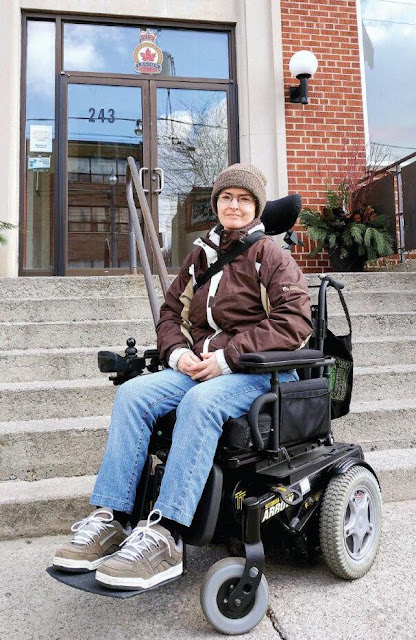As inflation drives up food prices and emergency COVID benefits expire, more people are looking for ways to take food production into their own hands.
For those without land or sunny windowsills, community gardens are a fantastic resource. My town has one just a few blocks from my apartment. For a small fee, I could rent a plot large enough to grow hundreds of pounds of food and potentially cut my grocery bill in half.
There’s only one problem: the garden is not accessible to me. In fact, it’s inaccessible to most disabled people.
Before you compose an angry letter on my behalf, please understand my intention isn't to call out or lead a protest against this particular garden or organization, which is why I haven’t included any identifying photos or information.
I hope to speak to the coordinator personally to address specific issues, but regardless of the outcome, I want to draw attention to the problems likely to arise at any community garden that doesn’t make accessibility a top priority.
Here are just a few of the access failures I’ve observed.
1. Location, location, location.
Gardeners can only access their plots via a narrow alley with poor visibility and no parking. A driver stopping to drop someone off risks being rear-ended.
Whoever chose the location must have assumed everyone would be able to walk or bike to the site, navigate a sharp slope, and cross a field that turns to solid mud in the spring.
Any wheelchair, walker, or cane user would struggle, and a power wheelchair could easily get stuck.
2. How low can you go?
Even if wheelchair users got to their plots, they wouldn’t be able to fit through the narrow openings in the wire fence or reach the ground-level beds. The area also has no seating or rest areas.
This setup excludes anyone who can’t stand for extended periods, bend, squat, reach, kneel, or lower their body to the ground with any chance of getting up again.
The solution for some of these problems already exists: raised beds.
Not only are they more accessible from a seated position, but they offer better drainage, soil aeration, and frost protection, which can extend the growing season. Custom designs can be pricey, but simpler setups use cinder blocks, salvaged wood, or eco-bricks.
3. Have trowel, must travel.
The burden of purchasing, transporting, storing, and disposing of gardening supplies falls entirely on individual gardeners. They must purchase seeds and seedlings separately rather than take advantage of bulk rates. There are no deliveries or trash collection.
Someone tills the beds at the beginning of the season and mows the surrounding grass regularly, but the weeds are overgrown, and the site lacks basic amenities like running water.
One plot contains a wagon full of plastic water jugs, but it’s unclear if others may use them. Rusty tools, slippery rolls of plastic, and bundles of wire litter the space, posing additional hazards.
Why force people to lug giant bags of fertilizer across town when a compost bin could produce free nutrients from plant waste on site? Why expect everyone to have the indoor space for seed starting and stockpiling when a tool shed and simple greenhouse could do the job?
Additional construction might raise the plot rental price, but this burden would be shared by all gardeners. Local hardware stores or nurseries might even donate building materials in exchange for the business the garden would send their way.
4. Are you there, God? It’s me, gardener.
Signing up for a plot isn’t easy. A phone number appears on a sign with small print, poor color contrast, and no braille. When I called, no one picked up, and the voicemail greeting identified the organization as a Protestant church several blocks away.
The contact person for the garden is likely a church secretary or volunteer with many other demands on their time. I wouldn’t expect them to answer the phone at all hours of the day, but I would prefer more options for communication.
Not being able to send a text message or email is an inconvenience for everyone but a major obstacle for the deaf, hard of hearing, or non-speaking, not to mention those with social anxiety.
If the church has a social media presence, group chat, or contact form, I was unable to find it.
After a lengthy search of the church website, I found one newsletter with information on the garden, including rules and requirements, but the file isn’t compatible with screen readers.
Although the garden plots are not limited to baptized parishioners, the religious affiliation is still problematic. Many disabled people are survivors of religious abuse.
We've been taught our existence is either a test of our parents' faith or a punishment for their sins. Some of us have been subjected to exorcisms. Strangers in public often lay hands on us without our consent to pray for miracles we don't want.
I know a woman who became disabled due to a bite from a preacher's rattlesnake. I know a child who drowned because a minister didn't know how to baptize someone with a tracheostomy.
Are the plot fees earmarked for the garden or could my money go to causes I don’t want to support? The rules don’t say.
To make matters worse, religious entities are under no legal obligation to provide access because they are exempt from the ADA. Churches may make it their mission to care for the poor and sick, but can the poor and sick even get through the door?
I don't deny that Christian charities often fill gaps in the social safety net, but these gaps should not exist.
5. Getting to know you… or not.
Gardeners who shy away from organized religion and don't join the congregation will have to garden alone. If we don’t already know our fellow gardeners, there's no easy way to contact them or arrange to meet, short of camping out and hoping another human shows up.
A community care model would allow us to share resources and help one another. If I'm too ill to garden at a crucial time, the rest of the group would know to harvest for me so my entire crop doesn't rot on the vine.
If all I manage to grow is a plot full of dandelions, others who've been there would have recipes to make the bitter greens palatable. If I grow more zucchini than I could ever eat, I could always trade it for someone else’s bumper crop of tomatoes.
Disabled elders who can't physically do the labor of gardening anymore could still mentor beginners and share their wealth of knowledge on canning, seed saving, and surviving hard times.
6. The not-so-great outdoors.
While vegetables thrive on full sunlight, not all humans are so lucky. This isn't a design flaw so much as an unfortunate reality. It’s difficult to enjoy the benefits of touching grass when you’re allergic to grass pollen.
For those most vulnerable, heat stroke, insect bites, soil microbes, or zoonotic diseases from nearby wildlife could prove fatal or lead to a costly hospital stay.
Although no pesticides are allowed in the garden, the surrounding properties have no restrictions. A nearby construction site sends up clouds of dust, a nightmare for asthmatics.
Although some of these problems are unavoidable, most accessibility issues can be resolved. Some have surprisingly quick fixes while others require a major investment of time, money, and effort.
But one thing is clear: disabled people were not the community the garden’s designers had in mind. We rarely are.
Do I, as a disabled gardener, have any options for growing even a little of my own food? The answer is yes, and it will be the subject of part 2 of this series.





I love reading anything you've written. This is not only about gardening, but it's about life. Your perspective is, always, so enlightening. But, your style of communicating and educating, is simply amazing!
ReplyDeleteThanks for reading!
Delete